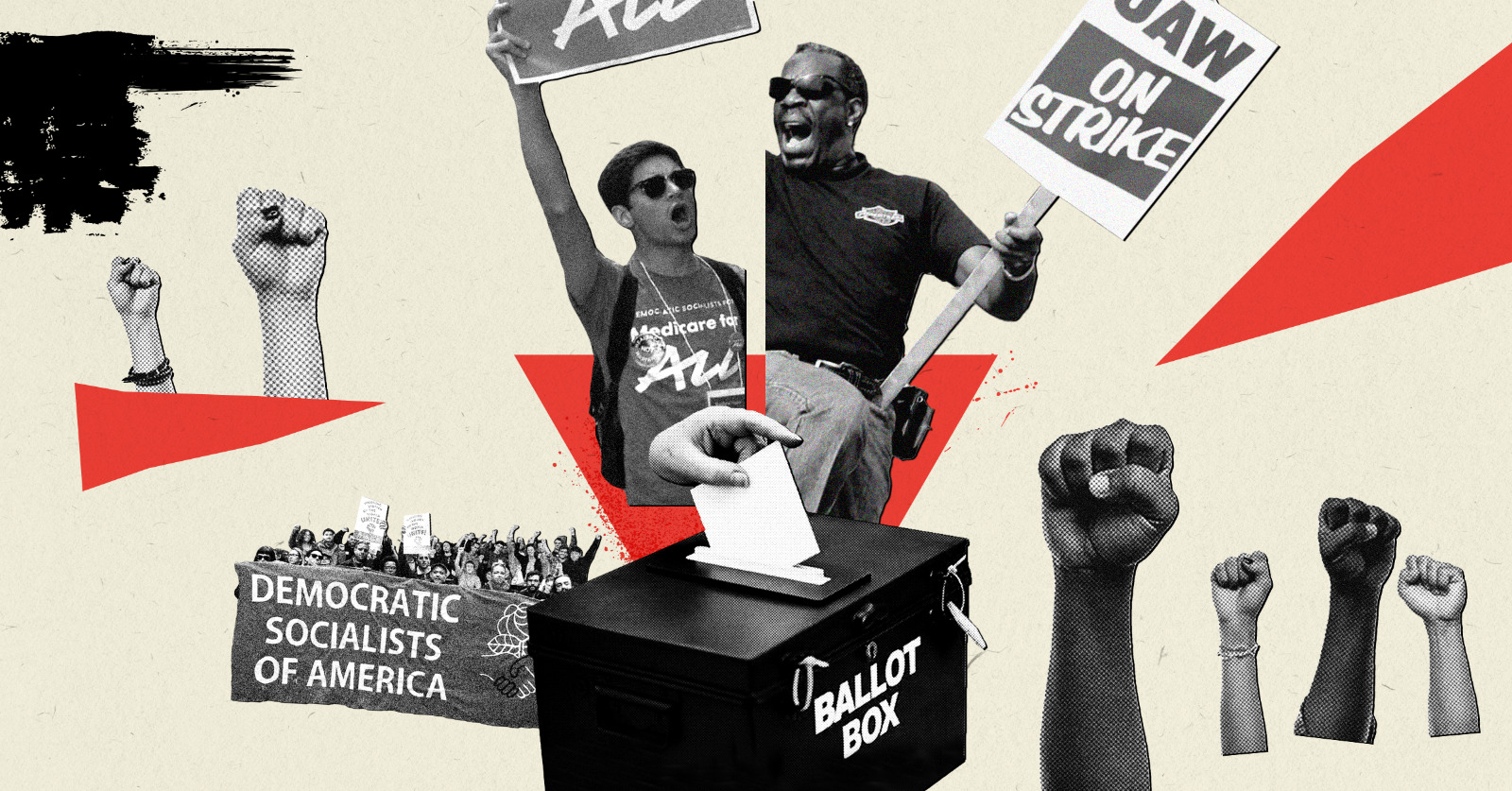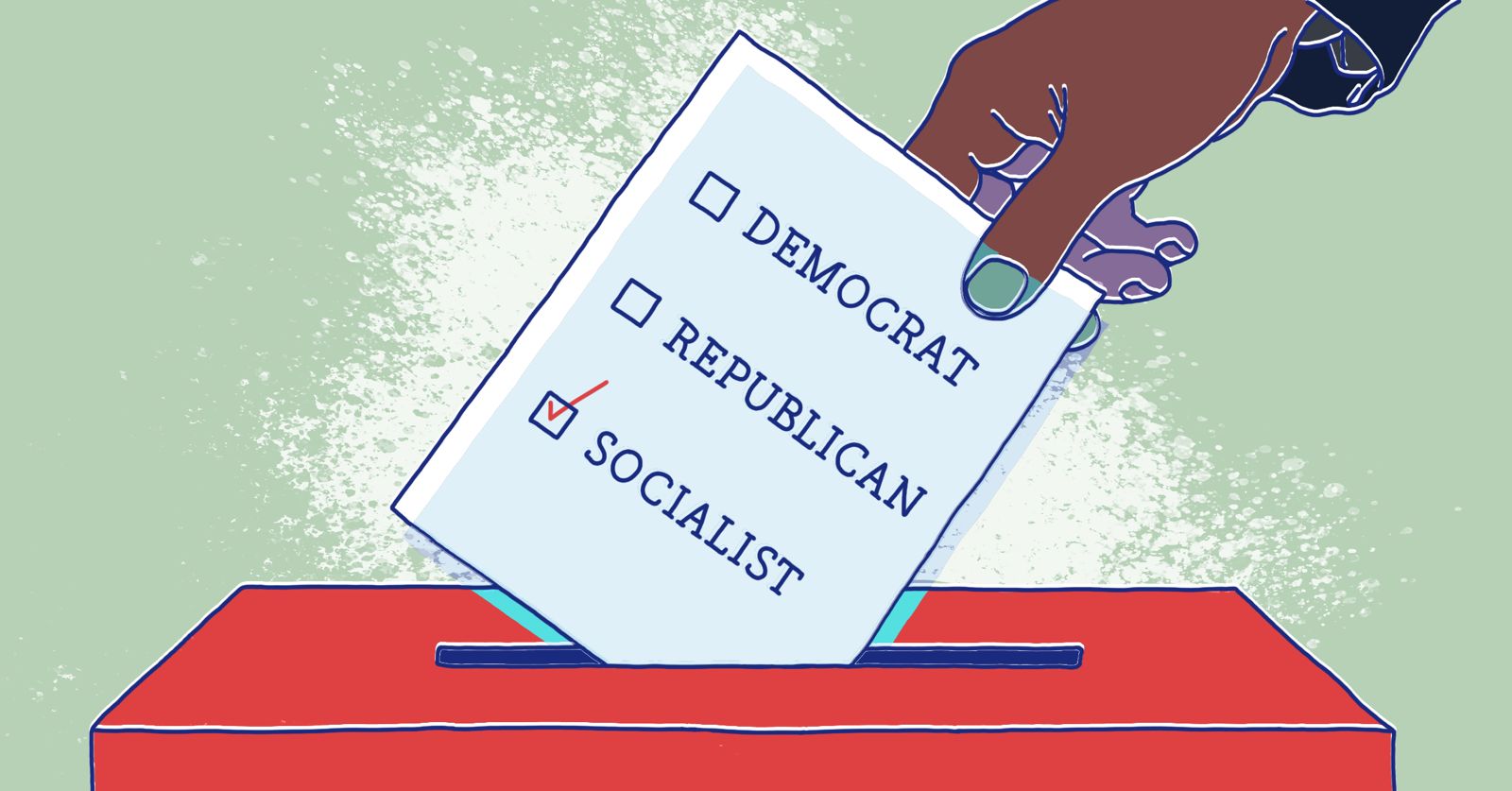The following article is a thought experiment by a DSA member about how a DSA-based labor party could function in the U.S. As socialists continue to discuss how to build an independent party, we hope others will contribute their ideas about what such a party could look like.
Debates on whether and how to pursue political independence are common in DSA. Among the groups that support independence and a break from the Democratic Party over the long term, what that break looks like is still debated. Should it be rapid or gradual? Will it be created by DSA itself or other forces from organized labor or social movements? Some debate has also been focused on the actual form of any independent party. Many people have made convincing cases for forms that shouldn’t be attempted with the Green Party being a common negative example. Less attention has been paid to the concrete relationships with working class institutions, most importantly labor unions, that could shape this work. The best answer to these questions is a labor party, but what kind? The last attempt in the United States to form a labor party came in the 1990s and fizzled out without ever running a serious campaign despite assembling an impressive group of Left unions to its cause.
How workers organized themselves in the past can tell us how this organizing can be done in the current US context.
Communist parties have had several kinds of relationships with trade unions depending on whether they hold state power. There has been a tendency to have official unions in the single party Marxist-Leninist states, where the unions have extremely limited independence from the party and state. Internal democracy is also limited and the trade union is treated as a “transmission belt” for the ideology of the party, an organization for instructing workers in the political thought of the party.
Where Communist parties have not taken state power, members have sought influence in unions through active participation in organizing and by taking positions of leadership without necessarily building formal connections between the party and the union. In the United States the members of Communist Party USA (CPUSA) were instrumental in achieving the high point of working class power, helping form the Congress of Industrial Organizations (CIO) and its constituent unions in heroic organizing campaigns in the mining, steel and eventually auto industry.
At its apex in terms of trade union power and socialist influence in mainstream politics, the CPUSA rejected the idea of forming a labor party, choosing the Popular Front strategy and labor peace in the factories as they prioritized the international fight against fascism over establishing socialism at home. After World War II the American state and the labor right were able to sweep the CPUSA out of the unions and consolidate an anti-communist politics in organized labor, severing the connection between organized workers and the socialist left.
Labor parties have been a common mode of parliamentary organization in the Anglophone world for over a century and provide a contrast to the general form of most Communist parties. The labor party form provides a direct connection with the organized working class by incorporating their organizations. Beginning with the first labor party, the Australian Labor Party founded in 1901, these are parties created by the trade unions directly, which may allow socialist groups to affiliate to them as well. These parties have socialists in them, but are not socialist parties. They have tended to be among the more conservative expressions of working-class politics in the world, more progressive than parties like the American Democratic Party where workers have limited influence, but still far behind other social democratic parties.
While it can be tempting to see these parties as a model for the US left because they have provided a voice for workers in government that is absent in our country and because they have established much more robust welfare states, it is important to understand the limits of this approach. If we copy their exact approach of forming a non-socialist front of all organized workers that socialists can participate in as one voice among many, we will likely get their similarly non-socialist results. A party project that takes us on the road to an American Tony Blair isn’t much better than the Democrats.
In the case of Communist parties, both in and out of power, we have a model where the party acts like a teacher and the organized workers in trade unions are treated like students. There is a one way flow of instruction, from the party and its cadre to the unions, but there is a socialist political horizon preserved. In the Anglophone labor parties there is a disarmament of the working class, where the defensive organizations of the working class have a political expression, but only compete within the boundaries of the capitalist system. These parties can fight for a redistribution of wealth or higher social wages within the system, but they also become a political expression of pure-and-simple unionism, without challenging the fundamental distribution of power.
What these approaches have shared is an acceptance of the central divisions in capitalism: the division of economy from politics and of private property from governance and the state. The lack of a shared political project among the unions also exacerbates the tendency for sectionalism in the unions and a tendency toward business unionism. In his 2001 book, Socialism or Barbarism, Hungarian socialist István Mészáros looked at the challenges of organizing workers politically in the 1990s after the fall of the Soviet Union and proposed a new way to solve the problem:
“There can be no hope for the radical re-articulation of the socialist movement without fully combining labor’s ‘industrial arm’ with its ‘political arm’; by conferring the power of meaningful political decision making on the trade unions (thus encouraging them to be directly political) on the one hand, and by making the political parties themselves defiantly active in industrial conflicts as the uncompromising antagonists of capital, assuming responsibility for their struggle.”
The US left needs a labor party where unions have a political voice and creative role and socialists organized in DSA are in a position to begin creating it.
The rules for a DSA-based labor party could be simple:
- Labor unions (nationals/internationals, regional labor councils, or individual locals) will be allowed to affiliate with DSA provided they accept its program (separate from the current platform, a shorter minimum program to be drafted at, or following the 2025 convention) and agree not to endorse opponents of any of its candidates in elections. Affiliated unions will pay an annual affiliation fee of $5 per member.
- Day to day, members of affiliated unions will participate as members of the DSA chapter they live within the territory of, or as at large members of the organization, but will elect delegates to convention through their union locals and will receive delegates proportional to their local’s membership as though it was a chapter of DSA.
- Individual dues will not be required to vote for delegates for convention, but individual membership in good standing will be required to serve as a convention delegate or to vote in chapter elections and meetings.
- Labor affiliate members will directly elect a portion of the National Labor Commission steering committee after convention.
This model of affiliation can be extended to other class organizations including tenants unions and cooperatives. An approach could be made to the United Electrical, Radio and Machine Workers of America (UE) as a first partner in this project, because of links that have been built between our organizations through work like the Emergency Workplace Organizing Committee (EWOC) over the years. UE and DSA are similar sized organizations so it would not feel as though one was swallowing the other.
Beyond UE we could begin looking to the independent-minded unions that have expressed support for a labor party, like the American Postal Workers Union (APWU) and their current president, Mark Dimondstein, or the unions that convened for the last attempt at creating a labor party in the 1990s. DSA chapters could also approach union locals that they have worked closely with during recent strikes, like in the Strike Ready campaign and more. Over the long term we should view the affiliation of major unions as one of the main paths for recruitment for the organization, side by side with one-on-one recruitment of individual socialists via campaigns.
DSA and the socialist movement have to deepen their roots in the working class and present a unifying political project. The way forward is a labor party, not as a front separate from socialists, but as a merger of the economic defensive organizations of the working class and the offensive political organizations. We should take this opportunity to move boldly toward a mass politics rooted in class struggle.




